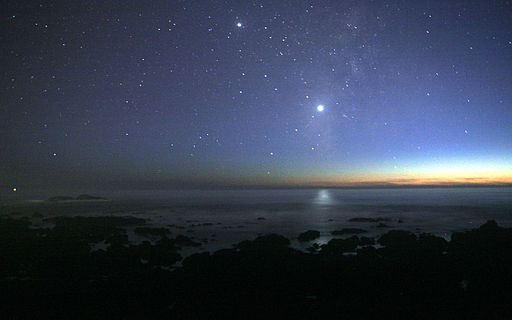 |
| Brocken Inaglory at the English Wikipedia [CC BY-SA (https://creativecommons.org/licenses/by-sa/3.0)] |
Lately, as part of another project, I've been working very closely with Shelob's Lair and The Choices of Master Samwise in Book Four, and The Tower of Cirith Ungol in Book Six of The Lord of the Rings. There is so much to comment upon in these chapters, so many links among them as well as between them and other chapters that it would take a discussion of some length to lay them all out.(Working on it.) There is one connection I finally recognized last night that I found so charming that I wanted to say a few words about it.
In Shelob's Lair the narrator points out that Gollum 'had bowed down and worshiped her, and the darkness of her evil will walked through all the ways of his weariness beside him, cutting him off from light and from regret' (TT 4.ix.723). I had long felt that we have here an echo of the Twenty-Third Psalm: 'surely goodness and mercy shall follow me all the days of my life' (23.6). I became certain of this the other day when I noted that in the hymn which Sam, without knowing what he is saying, sings to Elbereth, he uses the word 'nguruthos' (TT 4.x.729), which Tolkien translates in Letter 211 (p.278) as 'the shadow of (the fear of) death'.* It is hard to imagine that a man of Tolkien's time, upbringing, and piety, did not intend another echo of the same psalm: 'yea, though I walk through the valley of the shadow of death' (23.4).
Since Galadriel plays an important role, at least in the minds of Frodo and Sam during the episode with Shelob, I had also been thinking of her gift to Frodo of the star-glass to be 'a light when all other lights go out' and of her appearance in Sam's vision out of a blaze of blinding light. This moment when the darkness of Shelob is debilitating both Frodo and Sam seems to have been foreseen by Galadriel and provided for with her gift. The interplay of the powers of light and darkness in this scene also reminds us of what Haldir said of Galadriel's power: 'In this high place you may see the two powers that are opposed one to another; and ever they strive now in thought, but whereas the light perceives the very heart of the darkness, its own secret has not been discovered. Not yet' (FR 2.vi.352; cf. 2.vii.364-65).
The other night I was reading aloud to a particular friend what I had been writing about all this. She immediately quoted the Gospel of John (1.5) 'and the light shines in the darkness, and the darkness cannot comprehend it'.
And, as happens at such moments of revelation, the circle suddenly closed.
Allusion, of course, is what we find here, not allegory. The echoes of the Latin 'comprehenderunt', are heard quite loudly in the English translation of John, but in Tolkien, more fittingly, they sound as dimly as the horns of Elfland. Yet sound they do. The light of the silmaril as borne by Eärendil and captured in the water of Galadriel's mirror does not suggest that she or Eärendil are Christ figures. Rather, it is a matter of all myths reflecting the 'true' myth (the evangelium), and of all uses of the imagery of light and darkness to represent good and evil having common elements. Our knowledge of the one shapes and enhances our understanding of the other. If anything, so many of the characters suggested as 'Christ-figures' in The Lord of the Rings simply underline the need for Christ, for Eru to enter his creation himself, because the Children of Ilúvatar, being fallen, cannot overcome the evil that is the cause and consequence of their own fall.
It is intriguing also to note that the Earendel whom Tolkien found in the Old English poem Christ (1.104), and who sparked the creation of Middle-earth, was understood by some to represent Christ and by others John the Baptist**. In either event, he is the morning star, who presages the sun and brings light and hope to those who 'have had to endure the dark shadow of death' (1.118: deorc deaþes sceadu dreogan sceoldan), like Sam facing Shelob and like the speaker of the psalm.
Most interesting, finally, are the words of John the Evangelist*** who seems almost in dialogue with this question of who 'the Light' is, as if answering a question already raised during the lifetime of John the Baptist and Jesus -- some thought Jesus might be John come again, others that the Baptist might be the Messiah -- or anticipating that such a question would be raised again and clarifying the truth of the matter ahead of time (1.6-8):
There was a man sent from God, whose name was John. The same came for a witness, to bear witness of the Light, that all men through him might believe. He was not that Light, but was sent to bear witness of that Light.
Tolkien asserted that his work was 'fundamentally Christian'. He meant that adverb literally, as in 'at its foundation'. This makes sense because his themes are themselves at the foundation of our reality and Middle-earth's.
__________________________________
* The parenthesis glosses the words before it, explaining them, not adding to them.
** See
Cook The Christ of Cynewulf, a 1964 reprint of the 1909 impression, with the
notes beginning on p. 88. Since identification of Earendel with Christ or with John the Baptist, except perhaps by Tolkien, is not relevant here, I have not engaged with scholarship later than Tolkien's discovery of him. Given
Eärendil's role as the one who prepares the way for the (semi-)divine intervention of the Valar, Tolkien may have seen Earendel as more likely to be John the Baptist.
*** Coincidentally, perhaps, Tolkien regarded John the Evangelist as his patron saint (Letter 309), though the shared name was a coincidence.


